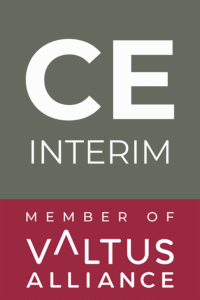Nicht genug Zeit, um den ganzen Artikel zu lesen? Hören Sie sich die Zusammenfassung in 2 Minuten an.
Bei einer erfolgreichen Interim-Mission geht es darum, die wichtigsten Kriterien und Ergebnisse zu definieren, die der Interim-Manager für die Kundenorganisation erzielt hat.
CE Interim bietet Interim-Manager auf höchstem Niveau, die Folgendes leisten Ergebnisse und Wert.
Eine Interim-Mission ist ein kurzfristiger Auftrag, bei dem eine erfahrene Fachkraft (der Interim-Manager) eingesetzt wird, um ein Projekt zu leiten, eine Krise zu bewältigen, eine Führungslücke zu schließen oder einen bedeutenden Wandel innerhalb der Organisation voranzutreiben.
Unsere Experten bei CE Interim können Ihnen helfen, diese Herausforderungen zu meistern.
Was ist eine Interimsmission?
Eine Interimsmission ist ein kurzfristiger Auftrag oder ein Projekt zur Erreichung bestimmter Ergebnisse innerhalb eines bestimmten Zeitrahmens. Sie ermöglichen es Organisationen, dringende Bedürfnisse zu befriedigen oder einen Übergang ohne langfristige Verpflichtungen zu bewältigen. Diese Missionen werden von erfahrenen Fachleuten geleitet, die über die richtigen Fähigkeiten für diese Aufgabe verfügen.
Zum Beispiel könnte ein Unternehmen einen Interim-CFO zur Stabilisierung der Finanzen während einer Fusion oder ein IT-Experte zur Bewältigung eines Cyberangriffs. Ganz gleich, ob es um die Verwaltung eines Projekts, die Bewältigung einer Krise oder die Umsetzung strategischer Veränderungen geht, Interimseinsätze bieten Flexibilität und Fachwissen, um schnell und effizient wichtige Ergebnisse zu erzielen.
Warum ist eine erfolgreiche Interimsmission zu definieren?
Die Definition einer erfolgreichen Interimsmission ist der Schlüssel zu organisatorischer Exzellenz und langfristigem Erfolg. Wenn Sie die Schlüsselkriterien definieren, können Sie sich leichter orientieren.
i) Organisatorische Leistung
Die Definition einer erfolgreichen Interimsmission hat einen großen Einfluss auf die Leistung der Organisation. Wenn Erfolg definiert ist:
- Erhöht die Gesamtproduktivität, indem er jedem eine klare Richtung vorgibt, der er folgen kann.
- Stärkt die Moral und den Fokus des Teams, indem er erreichbare Ziele setzt, um die Mitarbeiter zu motivieren und zu engagieren.
- Richtet die Strategie an den Zielen aus, so dass alle Bemühungen zu den langfristigen Visionen und Zielen der Organisation beitragen.
ii) Vorteile der Definition von Erfolgskriterien
Die Festlegung von Erfolgskriterien gibt Ihnen Sicherheit:
- Sie erhalten messbare Ziele, mit denen Sie Ihre Fortschritte verfolgen und bei Bedarf anpassen können.
- Hilft bei der Entscheidungsfindung, indem es Ihnen Daten und klare Erfolgsindikatoren liefert.
- Gewährleistet Rechenschaftspflicht und Transparenz, damit Sie die Verantwortlichen ermitteln und eine offene Kommunikation führen können.
iii) Zusätzliche Leistungen
Die Festlegung eines erfolgreichen Zwischenauftrags bietet mehr als nur eine unmittelbare Leistungsverbesserung:
- Vereinfacht die Kommunikation, damit die Teammitglieder die Erwartungen verstehen und effektiver zusammenarbeiten können.
- Ermittelt verbesserungswürdige Bereiche, damit Sie wachsen und sich anpassen können.
- Das Vertrauen der Stakeholder wird gestärkt, da klare Erfolgskriterien zeigen, dass Sie sich der Erreichung Ihrer Ziele verpflichtet fühlen.
Schlüsselmetriken für den Erfolg
1) Klare Zielsetzungen und Ziele setzen
Die Festlegung klarer Ziele ist der Schlüssel zum Erfolg für jede Organisation. Die Grundlage dafür ist SMART-Ziele: Spezifisch, messbar, erreichbar, sachdienlich und zeitgebunden. Diese Kriterien gewährleisten, dass die Ziele klar, nachvollziehbar, realistisch, auf die Gesamtstrategie abgestimmt und innerhalb eines Zeitrahmens liegen.
I) Schritte zur Zielsetzung:
a) Was will die Organisation erreichen?
- Bewerten Sie die aktuelle Leistung.
- Verstehen Sie Ihre Zukunftswünsche.
- Konsultation der wichtigsten Interessengruppen.
Auf diese Weise können Unternehmen spezifische Bereiche ermitteln, die verbessert werden müssen, und messbare Ziele festlegen.
b) Beispiel für ein SMART-Ziel: Ein Unternehmen könnte sich als Zwischenziel setzen, den Online-Umsatz in 6 Monaten um 15% zu steigern. Dieses Ziel ist:
- Konkret: Steigerung der Online-Verkäufe.
- Messbar: 15%.
- Erreichbar: Auf der Grundlage von Marktforschung.
- Relevant: Für das allgemeine Unternehmenswachstum.
Durch die Verknüpfung dieser Ziele mit der Gesamtstrategie können Unternehmen Fortschritte erzielen und die Dynamik aufrechterhalten.
2) Schnelles Onboarding und Anpassung
I) Die Rolle der schnellen Integration
a) Unternehmenskultur und -abläufe:
- Eine schnelle Integration in ein neues Unternehmen ist der Schlüssel zum Erfolg. Das Kennenlernen der Unternehmenskultur, der Werte, des Kommunikationsstils und der Arbeitsabläufe ermöglicht einen reibungsloseren Übergang und die Ausrichtung auf die Unternehmensziele.
b) Onboarding-Strategien:
- Umfassende Schulungen, Mentoring, Checklisten für die Einarbeitung und Zugang zu wichtigen Teammitgliedern sorgen für einen nahtlosen Übergang. Regelmäßige Kontroll- und Feedbackgespräche in den ersten Wochen klären alle Probleme.
II) Erzielung unmittelbarer Auswirkungen
a) Nutzen Sie Ihr Fachwissen für eine schnelle Wertschöpfung:
- Interim Manager können durch die Anwendung ihres Fachwissens sofort Ergebnisse liefern. Wenn sie erkennen, wo sie ihre Fähigkeiten einsetzen können, erzielen sie schnelle Erfolge, indem sie beispielsweise Prozesse analysieren, Verbesserungen vorschlagen oder wichtige Projekte in Angriff nehmen.
b) Beispiele für unmittelbare Maßnahmen und Entscheidungen:
- Ein Interim-Manager, der ein Unternehmen durch eine Krise steuert, den Betrieb nach einer Fusion integriert oder ein Werk verlagert, beweist seine Kompetenz und schafft Vertrauen bei den Kollegen. Die Konzentration auf eine schnelle Einarbeitung und Anpassung holt das Beste aus den Interim Managern heraus und sorgt dafür, dass sie vom ersten Tag an Leistung bringen.
3) Erreichen von wichtigen Meilensteinen
Die Einhaltung von Meilensteinen ist der Schlüssel zu jedem Projekt. Bei CE Interim Services wissen wir, dass Meilensteine dabei helfen, den Fortschritt zu verfolgen, rechtzeitig zu liefern und den Schwung zu erhalten. Hier erfahren Sie, warum die Verfolgung von Meilensteinen wichtig ist, welche Instrumente und Techniken zur Überwachung des Fortschritts eingesetzt werden und welche Strategien zur Einhaltung von Fristen es gibt.
I) Fortschrittsverfolgung mit Meilensteinen
a) Warum Meilensteinverfolgung:
- Die Verfolgung von Meilensteinen bietet einen klaren Plan, zeigt Aufgaben und Fristen. Die Festlegung von Meilensteinen bedeutet, dass sich Teams auf kurzfristige Ziele konzentrieren, potenzielle Blockaden erkennen und den langfristigen Erfolg vorantreiben können. CE Interim Services ist gut im Setzen und Einhalten von Meilensteinen.
b) Instrumente und Techniken für die Fortschrittsüberwachung:
- Die Fortschrittsverfolgung erfordert die richtigen Tools. Projektmanagement-Software wie Trello, Asana und Microsoft Project zeigt Meilensteine und Fristen an. Gantt-Diagramme und Kanban-Boards bieten visuelle Zeitleisten zur Überwachung und Anpassung von Plänen.
II) Fristen und Ergebnisse der Sitzungen
a) Pünktliche Lieferung:
- Wichtige Meilensteine gewährleisten eine rechtzeitige Lieferung. Die Aufteilung des Projekts in kleinere Abschnitte bedeutet, dass sich die Teams auf die rechtzeitige Fertigstellung jeder Phase konzentrieren können. Regelmäßige Statusbesprechungen und Fortschrittsberichte sorgen dafür, dass jeder zur Verantwortung gezogen wird. CE Interim Services ist pünktlich und phasenorientiert.
b) Fallstudien:
- Erfolgreiche Projekte setzen realistische Meilensteine, kommunizieren offen und passen sich an Veränderungen an. Diese Fallstudien geben Ihnen einen Einblick in die Meilensteinverfolgung. Bei CE Interim Services sind wir stolz auf unsere Projektabschlüsse und können unsere Kompetenz im Meilensteinmanagement unter Beweis stellen.
4) Operative Verbesserungen für mehr Effizienz
I) Effizienz und Abläufe
a) Suche nach Bereichen für operative Verbesserungen:
- Um wettbewerbsfähig zu bleiben, müssen Unternehmen ständig Bereiche für betriebliche Verbesserungen finden. Das bedeutet, dass gründliche Audits durchgeführt werden müssen, um Ineffizienzen und Blockaden in den aktuellen Prozessen zu finden. Die Interim-Manager von CE Interim können dabei helfen, Arbeitsabläufe zu analysieren, Mitarbeiter-Feedback einzuholen und Betriebsdaten zu überprüfen, um diese Bereiche zu finden.
b) Prozessverbesserungen:
- Sobald die verbesserungswürdigen Bereiche gefunden sind, ist es entscheidend, gezielte Prozessverbesserungen durchzuführen. CE Interim kann dabei helfen, neue Technologien einzuführen, Arbeitsabläufe zu verfeinern und Ressourcen neu zuzuweisen, um die Produktivität zu steigern. Unsere Interim-Manager führen auch regelmäßige Schulungen durch, um sicherzustellen, dass sich die Mitarbeiter an die Veränderungen und die allgemeine betriebliche Effizienz anpassen.
II) Problemlösung
a) Behebung und Lösung von Kernproblemen:
- Problemlösung ist der Schlüssel zur betrieblichen Verbesserung. CE Interim verwendet einen strukturierten Ansatz, um Kernprobleme durch Ursachenanalyse und strategische Lösungen zu beheben.
b) Beispiele für betriebliche Herausforderungen und Lösungen:
Betriebliche Herausforderungen unterscheiden sich je nach Branche. Das Fachwissen von CE Interim deckt mehrere Sektoren ab, so dass wir Lösungen für spezifische Probleme haben:
- Fertigung: Produktionsverzögerungen oder Geräteausfälle durch vorbeugende Wartungspläne und schlanke Produktion.
- Service Sector: Customer service bottlenecks by integrating advanced CRM systems and staff training programmes.
Indem sie sich auf diese operativen Verbesserungen konzentrieren und bei Bedarf das Interim Management von CE Interim nutzen, können Unternehmen ihre Effizienz und Prozesse verbessern und nachhaltig wachsen.
5) Finanzielle Auswirkungen: Kostensenkung und Einnahmesteigerung
I) Verwaltung von Kosten und Ressourcen
a) Strategien für die Haushalts- und Ressourcenverwaltung:
- Klare finanzielle Zielsetzungen: Abstimmung der kurz- und langfristigen finanziellen Ziele mit den Unternehmenszielen.
- Regelmäßige Budgetüberprüfung: Überprüfen Sie das Budget regelmäßig, um die Kosten zu senken, ohne die Qualität zu beeinträchtigen.
- Technologie: Einsatz von Software zur Budgetverfolgung und Ressourcenzuweisung.
b) Reale Beispiele für Kosteneinsparungen:
- Prozessautomatisierung: Ein Fertigungsunternehmen hat einige Prozesse automatisiert, um Arbeitskosten zu sparen.
- Energie-Effizienz: Ein Bürokomplex installierte energieeffiziente Systeme und senkte seine Stromrechnungen um 20%.
II) Förderung des Umsatzwachstums
a) Initiativen zur Steigerung der Einnahmen:
- Produktdiversifizierung: Einführung neuer Produkte oder Dienstleistungen für neue Märkte.
- Markterweiterung: Nutzen Sie digitales Marketing, um mehr Kunden zu erreichen.
- Kundenbindung: Führen Sie Treueprogramme für Wiederholungsgeschäfte durch.
b) Fallstudien zu den finanziellen Auswirkungen von Interimsmissionen:
- Projekt zur Optimierung des Vertriebs: Der Umsatz einer Einzelhandelskette stieg innerhalb von sechs Monaten mit einem Interimsmanager um 15%.
- Effizienz-Audit: Ein Interim-CFO half einem Tech-Startup, die monatlichen Ausgaben um 10% zu senken.
Das Gleichgewicht zwischen Kostenmanagement und Umsatzwachstum führt zu einer nachhaltigen finanziellen Wirkung.
6) Zufriedenheit der Stakeholder
I) Die Bedeutung von Kundenfeedback
a) Sammeln und Analysieren von Feedback:
- Das Einholen und Analysieren von Rückmeldungen der wichtigsten Interessengruppen ist für jedes Unternehmen, das langfristig erfolgreich sein will, von entscheidender Bedeutung. Durch das Einholen von Kundenfeedback können sich Unternehmen ein Bild davon machen, wie sie arbeiten und in welchen Bereichen sie sich verbessern müssen. Die Analyse dieses Feedbacks zeigt Trends und Muster auf, die in die Strategie einfließen können.
b) Methoden zur Sammlung von Feedback:
Es gibt viele Möglichkeiten, Feedback zu sammeln:
- Umfragen und Fragebögen: Versenden Sie nach einem Projekt Umfragen an Kunden, um detailliertes Feedback zu erhalten.
- Interviews und Fokusgruppen: Führen Sie Interviews oder Fokusgruppen durch, um ein detailliertes Feedback zu erhalten.
- Online-Bewertungen und soziale Medien: Beobachten Sie Online-Bewertungen und soziale Medien, um Echtzeit-Feedback zu erhalten.
II) Bedenken der Interessengruppen
a) Strategien zur Befriedigung:
Der Schlüssel zur Zufriedenheit liegt darin, auf die Anliegen der Betroffenen schnell und gut einzugehen. Die Strategien umfassen:
- Reaktionsfähige Kommunikation: Aufrechterhaltung offener und transparenter Kommunikationskanäle.
- Umsetzung von Änderungen: Reagieren Sie auf Feedback, indem Sie notwendige Änderungen und Verbesserungen vornehmen.
- Regelmäßige Updates: Halten Sie die Beteiligten über die Fortschritte und Änderungen auf dem Laufenden, die als Reaktion auf ihr Feedback vorgenommen wurden.
Wenn Unternehmen auf das Feedback ihrer Kunden hören und darauf reagieren, können sie engere Beziehungen aufbauen, die Zufriedenheit steigern und sich kontinuierlich verbessern.
7) Wissenstransfer und Vermächtnis
I) Transfer von Fertigkeiten
Der Kompetenztransfer ist der Schlüssel zum Unternehmenswachstum.
So stellen Sie den Kompetenztransfer zum Stammpersonal sicher:
- Strukturierte Schulung: Nutzen Sie Workshops, Online-Kurse und praktische Übungen zur Vermittlung von Schlüsselqualifikationen.
- Mentorenschaft: Bringen Sie erfahrene Mitarbeiter mit Neueinsteigern zusammen, um Wissen zu teilen.
- Dokumentation: Führen Sie detaillierte Aufzeichnungen über Prozesse und bewährte Verfahren.
- Regelmäßige Überprüfungen: Führen Sie regelmäßige Leistungskontrollen durch, um sicherzustellen, dass die Fähigkeiten erhalten bleiben.
Zu den langfristigen Vorteilen gehören Effizienz, ein geringerer Bedarf an Interimsmanagern und eine sachkundige Belegschaft.
II) Nachhaltige Praktiken
Nachhaltigkeit ist der Schlüssel zu langfristigem Erfolg. Setzen Sie diese Schritte um:
- Systemintegration: Installieren Sie energieeffiziente Technologien und nachhaltige Praktiken in der Lieferkette.
- Entwicklung von Strategien: Durchsetzung von Strategien für Recycling, Abfallverringerung und umweltfreundliche Beschaffung.
- Engagement der Mitarbeiter: Beziehen Sie Ihre Mitarbeiter durch Workshops, grüne Teams und Anreize in das Thema Nachhaltigkeit ein.
- Kontinuierliche Verbesserung: Aktualisieren Sie die Nachhaltigkeitsmaßnahmen regelmäßig.
Unternehmen wie Google und Unilever haben sich auf nachhaltige Praktiken eingestellt, sie setzen auf erneuerbare Energien und Abfallvermeidung.
Indem sie Wissen weitergeben und Nachhaltigkeit praktizieren, werden Organisationen langfristig erfolgreich sein und ein Vermächtnis hinterlassen.
8) Kulturelle Anpassung und Führung
I) Anpassung des Führungsstils an die Unternehmenskultur
a) Warum die kulturelle Ausrichtung wichtig ist
Führungspersönlichkeiten, die die Werte des Unternehmens widerspiegeln, leiten ihre Teams und schaffen eine geschätzte Kultur des Zusammenhalts.
b) Wie man sich kulturell integriert
- Lernen Sie die Kultur kennen: Verstehen Sie den Auftrag, die Werte und Normen der Organisation.
- Offen kommunizieren: Bringen Sie die Führung durch Transparenz mit den kulturellen Erwartungen in Einklang.
- Mitarbeiter einbeziehen: Beziehen Sie sie in die Entscheidungsfindung ein, um ihren Beitrag zu würdigen.
- Seien Sie flexibel: Seien Sie offen für Feedback und passen Sie sich an, wenn sich die Kultur weiterentwickelt.
II) Vertrauen und Zusammenarbeit
a) Vertrauen aufbauen
- Seien Sie konsistent: Vorhersehbare Handlungen schaffen Vertrauen.
- Transparent bleiben: Ein offener Informationsaustausch verringert Missverständnisse.
- Anstrengungen anerkennen: Motiviert und stärkt das Selbstvertrauen.
- Unterstützung gewähren: Ressourcen für Wachstum bereitstellen.
Zusammenfassend lässt sich sagen, dass Führungskräfte, die kulturell angepasst sind und Vertrauen aufbauen, langfristig erfolgreich sein werden.
9) Bewertung nach der Mission
I) Bewertung der Auswirkungen der Mission
a) Werkzeuge und Methoden
Nutzen Sie Umfragen, Interviews, Datenanalysen und Leistungskennzahlen, um die Auswirkungen der Mission zu bewerten.
b) Messung langfristiger Auswirkungen
Verfolgen Sie die wichtigsten Leistungsindikatoren (KPIs) im Laufe der Zeit mit Längsschnittstudien und Nachuntersuchungen, um nachhaltige Verbesserungen oder Probleme zu bewerten.
II) Dokumentation der gemachten Erfahrungen
a) Wichtigkeit
Dokumentieren Sie Erfolge und Misserfolge, um eine kontinuierliche Verbesserung zu erreichen und die Wiederholung von Fehlern zu vermeiden.
b) Anwendung
Nutzen Sie die Erkenntnisse, um bewährte Verfahren zu entwickeln, Prozesse zu verfeinern und Schulungen zu verbessern, und fördern Sie so eine Kultur der Spitzenleistung und Anpassungsfähigkeit.
Schlussfolgerung
Die Definition einer erfolgreichen Interimsmission erfordert einen vielschichtigen Ansatz, der die finanziellen Auswirkungen, die Zufriedenheit der Interessengruppen, den Wissenstransfer, die Nachhaltigkeit und die kulturelle Ausrichtung einschließt. Jede Komponente ist der Schlüssel zum langfristigen Erfolg.
CE Interim Services zeichnet sich bei der Bewältigung dieser komplexen Aufgaben durch sein Fachwissen aus. Unsere erfahrenen Fachleute übertreffen die Erwartungen unserer Kunden durch strategische Planung und maßgeschneiderte Ausführung. Wir stellen sicher, dass Ihr Interim-Einsatz einzigartige Herausforderungen angeht, unmittelbare Ergebnisse bringt und kontinuierliche Verbesserungen fördert.
Vertrauen Sie CE Interim Services, um die Komplexität des Interim-Managements zu bewältigen und eine nachhaltige Wirkung für den zukünftigen Erfolg Ihres Unternehmens zu erzielen.





